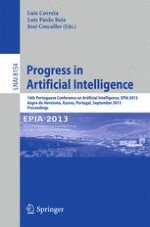This book constitutes the refereed proceedings of the 16th Portuguese Conference on Artificial Intelligence, EPIA 2013, held in Angra do Heroísmo, Azores, Portugal, in September 2013. The 45 revised full papers presented were carefully reviewed and selected from a total of 157 submissions. The papers are organized in the following topical sections: ambient intelligence and affective environments; artificial intelligence in transportation systems; artificial life and evolutionary algorithms; computational methods in bioinformatics and systems biology; general artificial intelligence; intelligent robotics; knowledge discovery and business intelligence; multi-agent systems: theory and applications; social simulation and modeling; and text mining and applications.
